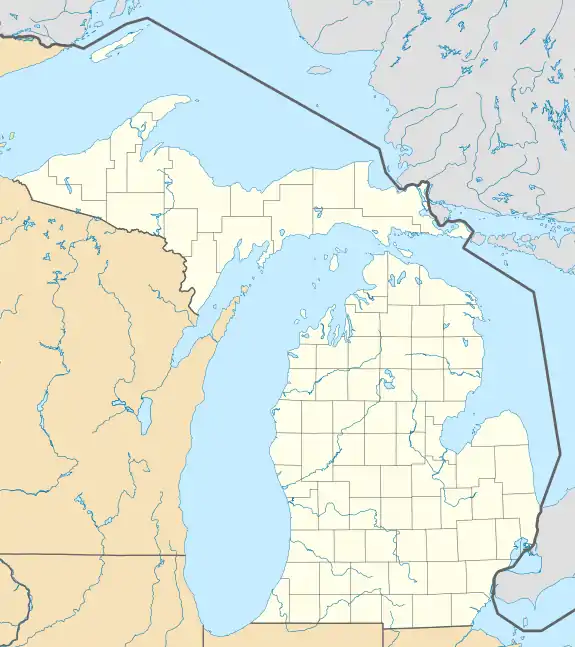Schoolcraft Furnace site | |
 Schoolcraft Furnace Site, 2010 | |
  | |
| Nearest city | Munising, Michigan |
|---|---|
| Coordinates | 46°25′26″N 86°37′21″W / 46.42389°N 86.62250°W |
| Area | 10 acres (4.0 ha) |
| Built | 1867 |
| Architect | Peter White, Henry Mather |
| NRHP reference No. | 77000151[1] |
| Added to NRHP | December 28, 1977 |
The Schoolcraft Furnace site is an abandoned iron furnace site located just east of Munising, Michigan, within the Pictured Rocks National Lakeshore near the Munising Falls Visitor Center.[2] It was listed on the National Register of Historic Places in 1977.[1] It is also known as the Munising Furnace.
History

Munising was founded in 1850 as a resort village[3] by the Munising Company, but the company's capital was over extended and their plan never came to fruition.[2] Two more companies were formed to develop the Munising Company's assets, but neither prospered.[2] In 1866, Henry Mather and Peter White acting as agents for a group of investors, purchased the land around Munising and created the Schoolcraft Iron Company.[3] A site for the furnace was selected on Munising Creek, about 1100 feet from Munising Bay,[3] and in 1867 construction was started on a furnace.[2] A stack was built from sandstone quarried locally on Grand Island,[4] furnace machinery was brought in from Newburgh, New York, and about 500 people were employed cutting cordwood.[3] The Schoolcraft Furnace was fired the first time on June 28, 1868.[5]
The furnace used iron ore shipped in via rail from Negaunee and Ishpeming to Marquette, and thence by boat to Munising.[3] Charcoal was made in kilns within a few miles of the furnace; seventeen of these have been located.[3] The furnace also used limestone shipped in from the Lake Erie region.[3] A small steam engine was operated to crush the ore and a larger one supplied air to the furnace.[3]
However, after the first fire, the furnace was run only irregularly.[5] Problems with wet charcoal and shortages of ore or charcoal forced several shutdowns.[3] Despite this, by 1869 the furnace was putting out an average of 20 tons of pig iron per day.[3] However, finances for the furnace were shaky, and poor business decisions in 1870 increased the Schoolcraft Iron Company's debt until it collapsed into bankruptcy[5] in October 1870.[3]
Peter White organized a new company, the Munising Iron Company, and purchased the furnace in 1871.[2][3] The furnace was reopened in the fall of that year, and ran for 12 months, making a total of 2500 tons of iron.[3] It was shut down in the fall of 1872 to add a hopper and bell, improving efficiency.[3] The furnace was back online in May, but only four months later the Panic of 1873 hit, driving down iron prices.[3] The furnace was online again for 24 weeks in 1875 before a lack of iron and charcoal shut it down again.[3] In 1876, the furnace was leased to Henry Pickands, who ran it until November 1877, when it was leased to Daniel Rankin.[3] Rankin intended to fire the furnace in 1878, but was no able to, and the furnace was shut down for good.[3]
The final closing of the Schoolcraft Furnace devastated Munising, and many people in the town left to seek work elsewhere.[3] Munising declined until the Munising Railway was opened in 1895, and a large tannery was established later, providing more jobs for the area.[6] In 1901, the furnace machinery was purchased by the Lake Superior Iron and Metal Company of Hancock, Michigan; much of the equipment was melted down as scrap and remade into machinery for the copper mines of the Keweenaw Peninsula.[3]
The Schoolcraft Furnace was placed on the National Resister of Historic Places in 1977. The remains of the site are difficult to distinguish; the old road trace is now a hiking trail, and some of the rubble pile can be identified in the now-wooded area.[3] The ruins of what might have been a corduroy road are visible in the creek.[3] The area is publicly accessible from the Munising Falls Visitor's Center.[2]
Forge site images, 2010
|
|---|
References
- 1 2 "National Register Information System". National Register of Historic Places. National Park Service. March 13, 2009.
- 1 2 3 4 5 6 David Koenig (October 21, 1976), NATIONAL REGISTER OF HISTORIC PLACES INVENTORY - NOMINATION FORM: Schoolcraft Furnace
- 1 2 3 4 5 6 7 8 9 10 11 12 13 14 15 16 17 18 19 20 21 22 23 "Schoolcraft Blast Furnace" (PDF). National Park Service. Retrieved December 5, 2010.
- ↑ Kathryn Bishop Eckert (2000), The sandstone architecture of the Lake Superior region, Wayne State University Press, pp. 92–93, ISBN 0-8143-2807-5
- 1 2 3 Alfred P. Swineford (1876), History and review of copper, iron, silver, slate and other material interests of the south shore of Lake Superior, The Mining journal, p. 223
- ↑ Alvah Littlefield Sawyer (1911), A history of the northern peninsula of Michigan and its people: its mining, lumber and agricultural industries, The Lewis Publishing Company, p. 387, ISBN 9780598489524




